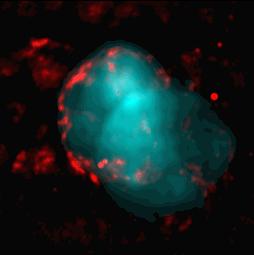Composite RemnantsThese remnants are a cross between shell-like and Crab-like remnants. Exact definitions differ, depending on whether you are a radio or an x-ray astronomer. To a radio astronomer, a composite remnant is one which shows emission in the center and in a shell in both the x-ray and the radio. To an x-ray astronomer, a composite remnant is one which shows a shell in the radio and plerionic emission in the x-ray. The spectrum of the x-rays from the center are thermal, line dominated. An example of this type of remnant is IC 433.html (below). In this image, red shows radio emission and blue shows X-ray emission. The radio emission is distributed in a shell while the X-ray emission is center-filled.
(Image courtesy of Jonathan Keohane). 
IMAGES |
By Mission |
Stars |
HEASARC Home | Observatories | Archive | Calibration | Software | Tools | Students/Teachers/Public Last modified: Tuesday, 08-Feb-2005 15:02:34 EST |

